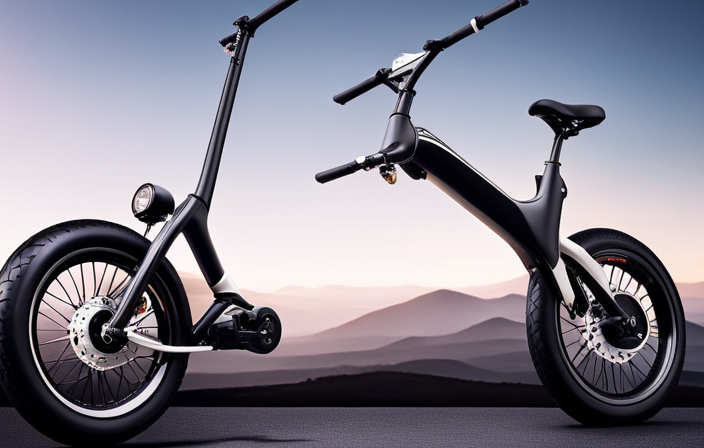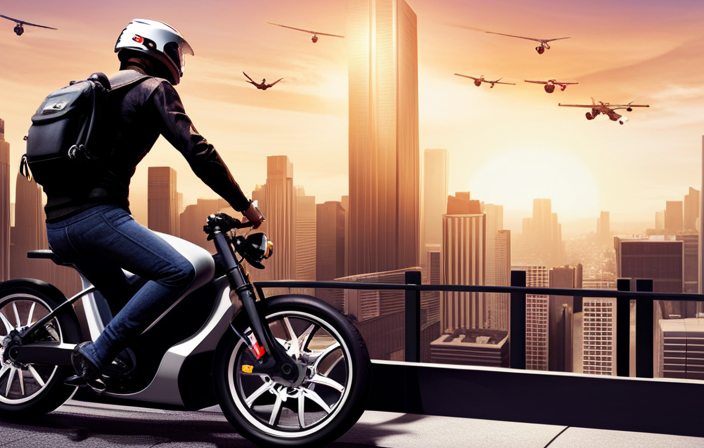Have you ever thought about why your electric bike keeps shutting off at the worst possible times? Well, worry no more, because in this article, I will explore the different reasons behind this annoying problem.
From loose or faulty connections, battery problems, and motor malfunctions, to controller glitches, wiring issues, and even user error, we will explore every possible cause.
So, buckle up and get ready to uncover the technical mysteries that might be plaguing your electric ride.
Key Takeaways
- Electrical issues such as loose or faulty connections, battery issues, motor problems, and controller malfunction can cause an electric bike to keep cutting out.
- Throttle issues, including loose or broken throttle and throttle calibration problems, can also lead to the bike cutting out.
- Misalignment or loose connections in the braking system can interfere with the bike’s performance and cause it to cut out.
- Environmental factors like extreme temperatures and moisture or water damage can impact the bike’s electrical system and result in cutting out.
Loose or Faulty Connections
If your electric bike keeps cutting out, it could be due to loose or faulty connections. When it comes to troubleshooting loose connections, the first step is to check all the wiring connections on your bike. Make sure they are securely fastened and free from any corrosion or damage. If you find any loose connections, tighten them using a screwdriver or pliers.
However, if you suspect a faulty wire, it may need to be replaced. Inspect the wires carefully for any signs of wear or fraying. If you notice any damage, it’s best to replace the wire entirely. Remember, maintaining proper electrical connections is crucial for the smooth functioning of your electric bike.
Now, let’s move on to the next section and discuss battery issues.
Battery Issues
To troubleshoot battery issues, you should first check if it’s fully charged. Proper battery charging is crucial for the smooth operation of your electric bike. Insufficient charging can lead to frequent cutouts. Make sure to follow the manufacturer’s instructions for charging your battery.
Additionally, keep in mind that the battery lifespan can be affected by various factors such as temperature, usage patterns, and maintenance. Regularly inspect the battery for any signs of damage, corrosion, or loose connections. Ensure that the battery is securely attached to the bike. If you notice any issues, consider getting the battery tested or replaced.
Addressing battery issues is essential to maintain the overall performance and longevity of your electric bike.
Now, let’s move on to motor problems and how to troubleshoot them effectively.
Motor Problems
When troubleshooting motor problems, you should check if it’s making any unusual noises. Unusual noises can be an indication of underlying issues such as motor overheating or mechanical problems. If you hear grinding, clicking, or buzzing sounds coming from the motor, it is important to address the problem promptly to prevent further damage. To help you identify and understand motor problems better, here is a table highlighting common motor issues, their symptoms, and possible solutions:
| Motor Problem | Symptoms | Possible Solutions |
|---|---|---|
| Motor Overheating | Motor feels hot to the touch | Check for proper ventilation |
| Motor Noise | Grinding, clicking, buzzing sounds | Inspect and lubricate moving parts |
Controller Malfunction
To address the issue of a controller malfunction, you should first check the wiring connections and ensure they are secure. A loose or faulty connection can result in intermittent power supply to the motor, causing it to cut out.
Additionally, a controller malfunction can lead to motor overheating and excessive battery drain. If you notice the motor overheating or the battery draining quickly, it is likely due to a malfunctioning controller.
To diagnose the problem further, you can use a multimeter to test the voltage and resistance of the controller’s components. If any readings are outside the recommended range, it may indicate a faulty component that needs to be replaced.
Now, let’s move on to the next section to discuss potential wiring problems that can also cause the electric bike to cut out.
Wiring Problems
Check the wiring connections to make sure they are secure and not causing any potential problems with your electric bike. Faulty wiring can lead to electrical shorts, which can cause your bike to cut out unexpectedly.
Here are some steps to troubleshoot wiring problems:
-
Inspect the wiring harness for any signs of damage or wear. Look for frayed wires or exposed connections.
-
Ensure that all connectors are properly plugged in and tightly secured.
-
Use a multimeter to test the continuity of the wires. Look for any breaks or inconsistencies in the electrical flow.
-
If you find any faulty wiring, replace the affected components or repair the connections.
By addressing any wiring issues, you can prevent electrical shorts and keep your electric bike running smoothly.
Now, let’s move on to the next section to discuss sensor issues.
Sensor Issues
One common issue with electric bikes is sensor malfunctions, which can affect the overall performance of the bike. Sensor calibration is crucial to ensure accurate readings and smooth operation. Troubleshooting sensor issues can be done using the following tips:
| Sensor Issue | Possible Cause | Troubleshooting Tips |
|---|---|---|
| Speed Sensor | Loose or damaged wiring | Check and secure all connections |
| Incorrect placement | Re-position the sensor properly | |
| Malfunctioning sensor | Replace the sensor if necessary | |
| Torque Sensor | Loose or damaged wiring | Inspect and repair any wiring issues |
| Faulty sensor | Replace the sensor if needed | |
| Pedal Assist Sensor | Loose or damaged wiring | Check and fix any wiring problems |
| Misalignment | Adjust the sensor for proper alignment | |
| Defective sensor | Replace the sensor as required |
Throttle Problems
I’ve encountered some issues with my electric bike’s throttle recently. One possible problem could be a loose or broken throttle, which can cause inconsistent acceleration or even a complete loss of control.
Another issue that may arise is throttle calibration problems, where the throttle input does not match the actual output of the motor, leading to unpredictable power delivery.
These throttle problems can greatly affect the performance and safety of the electric bike, and it’s important to address them promptly.
Loose or Broken Throttle
Make sure you’re not accidentally pressing the throttle too hard, as this can cause it to become loose or broken. It’s important to maintain a proper throttle adjustment to ensure smooth operation of your electric bike.
Here are a few things to consider:
- Check the throttle adjustment: Make sure the throttle is securely attached and not wobbling.
- Inspect the throttle cable: Look for any signs of damage or fraying that may indicate a broken throttle cable.
- Tighten any loose connections: If you notice any loose nuts or bolts, tighten them to ensure a secure throttle assembly.
- Test the throttle function: Make sure the throttle responds smoothly and consistently when you apply pressure.
By addressing these potential issues with the throttle, you can prevent a loose throttle adjustment or a broken throttle cable from causing your electric bike to cut out unexpectedly.
Now, let’s move on to discussing throttle calibration issues.
Throttle Calibration Issues
To ensure smooth operation of your electric bike, it’s important to address throttle calibration issues by following these steps.
Throttle calibration is crucial for maintaining accurate throttle sensitivity and preventing any sudden cuts or surges in power. If you’re experiencing issues with inconsistent throttle response or your bike cutting out unexpectedly, it may be due to a calibration problem.
Start by locating the throttle calibration settings on your electric bike’s display. Consult the user manual for specific instructions on how to access these settings. Once you’ve accessed the calibration settings, follow the troubleshooting tips provided in the manual to recalibrate the throttle.
By properly calibrating the throttle, you can ensure that your electric bike operates smoothly and responds accurately to your input.
Speaking of smooth operation, another potential issue that may cause your bike to cut out is a display malfunction.
Display Malfunction
The electric bike’s display’s malfunction may be causing it to keep cutting out. When the display malfunctions, it can disrupt the communication between the bike’s components, leading to sudden power loss.
To resolve this issue, here are three troubleshooting techniques to consider:
-
Check for loose connections: Ensure that all the cables connecting the display to the bike’s system are securely plugged in. A loose connection can cause intermittent power interruptions.
-
Inspect for damage: Examine the display for any signs of physical damage, such as cracks or water ingress. If damage is detected, a display replacement may be necessary to restore proper functionality.
-
Reset the display: Some displays have a reset option in the settings menu. Try resetting the display to its factory settings to see if it resolves the cutting-out issue.
Now, let’s delve into the next section about potential ‘braking system interference’ without skipping a beat.
Braking System Interference
Check if the braking system is interfering with other components by inspecting for any signs of misalignment or loose connections.
Proper braking system maintenance is crucial for the overall performance and safety of your electric bike. When troubleshooting braking issues, it is important to start by checking for any interference between the braking system and other components.
Look for any signs of misalignment, such as the brake calipers rubbing against the wheel or the brake pads not fully releasing after braking. Additionally, check for loose connections in the brake cables or hydraulic lines. These issues can cause the braking system to malfunction and potentially cut out.
By addressing any misalignment or loose connections, you can ensure that the braking system functions properly and does not interfere with other components.
Now, let’s move on to the next section and explore the impact of environmental factors on electric bike performance.
Environmental Factors
When it comes to the performance and longevity of electronic devices like electric bikes, environmental factors play a crucial role.
Extreme temperatures can have a significant impact on the overall functionality of the bike’s components, potentially leading to performance issues or even failure.
Moisture or water damage can be equally detrimental, as it can corrode the electrical connections and circuitry, compromising the bike’s operation.
Therefore, understanding how extreme temperatures and moisture can affect electric bikes is crucial in ensuring their optimal performance and durability.
Extreme Temperatures
Make sure you’re not exposing your electric bike to extreme temperatures, as this could be causing it to cut out. High altitude can have a significant impact on the performance of your electric bike’s battery. At higher altitudes, the air becomes thinner, which affects the cooling efficiency of the battery. This can result in overheating and subsequent cutouts. Additionally, extreme cold temperatures can cause the battery’s chemical reactions to slow down, reducing its capacity and overall performance.
To avoid these issues, here are some tips:
- Store your electric bike in a temperature-controlled environment when not in use.
- Avoid leaving your bike in direct sunlight or exposed to extreme heat for extended periods.
- If you’re riding in high altitude areas, consider using a bike with a battery specifically designed for such conditions.
- Insulate your battery during cold weather by using a battery cover or wrapping it with insulation material.
Exposing your electric bike to extreme temperatures can lead to battery degradation and unexpected cutouts. Now, let’s move on to the next section and discuss the potential impact of moisture or water damage.
Moisture or Water Damage
To prevent moisture or water damage, ensure you store your e-bike in a dry location and avoid riding it in heavy rain or through puddles. The impact of humidity on electric bike performance can be significant. Humidity can cause the electrical components of the bike to corrode, leading to malfunctioning or even total failure.
The effects of rainwater on electric bike circuitry can be equally damaging. Water can seep into the delicate circuitry, causing short circuits and rendering the bike inoperable. It is crucial to keep the bike’s electrical components dry and protected at all times.
If you do accidentally expose your e-bike to moisture, make sure to thoroughly dry it and inspect for any signs of damage before using it again.
Now, let’s move on to the next section and discuss the importance of firmware or software updates in ensuring optimal e-bike performance.
Firmware or Software Updates
Updating the firmware or software could potentially resolve the issue of the electric bike cutting out. Firmware and software updates are crucial for the optimal performance of electric bikes. Regularly checking and updating the firmware or software ensures that the bike’s operating system is up to date, improving its overall functionality and reliability.
These updates can have a significant impact on the bike’s performance, addressing any bugs, glitches, or compatibility issues that may be causing the sudden cutouts. By keeping the bike’s firmware and software updated, riders can enjoy a smoother and more consistent riding experience.
However, it is important to note that user error can also contribute to the bike cutting out, which will be discussed in the next section.
User Error
It’s important to be aware of user error as a potential cause of the electric bike malfunctioning. User education plays a crucial role in troubleshooting techniques to address such issues. Here are some key points to consider:
- Incorrect battery installation: Make sure the battery is properly aligned and securely connected.
- Improper charging: Follow the manufacturer’s guidelines for charging the battery to avoid overcharging or undercharging.
- Faulty controls: Double-check the settings and controls to ensure they are set correctly and not accidentally changed.
- Inadequate maintenance: Regularly clean and inspect the bike for any loose connections, worn-out components, or signs of damage.
- Misuse of power modes: Understanding the different power modes and using them appropriately can prevent unnecessary strain on the bike’s electrical system.
By understanding and addressing these user errors, you can troubleshoot and resolve many common electric bike issues.
Now, let’s move on to the section about mechanical problems.
Mechanical Problems
Moving on from user errors, let’s delve into the realm of mechanical problems that may be causing your electric bike to cut out.
Regular mechanical maintenance is crucial to ensure optimal performance and prevent issues like sudden power loss. Here are some troubleshooting tips to get to the root of the problem.
First, check the battery connections to ensure they are secure and clean. Loose or corroded connections can disrupt the flow of power.
Next, inspect the motor and controller for any signs of damage or overheating. Overheating can cause the system to shut down as a safety measure.
Additionally, check the wiring harness for any frayed or damaged wires that may be causing a short circuit.
By addressing these mechanical issues, you can eliminate potential causes of power loss and keep your electric bike running smoothly.
Now, let’s explore the impact of overloading or weight distribution on your electric bike’s performance.
Overloading or Weight Distribution
Inspect the load you’re carrying and how it’s distributed to ensure optimal performance and prevent power loss on your e-bike. Here are four key points to keep in mind when it comes to overloading risks and weight distribution considerations:
-
Maximum Weight Capacity: Check your e-bike’s maximum weight capacity specified by the manufacturer. Exceeding this limit can strain the motor and battery, leading to power loss or even mechanical failures.
-
Even Weight Distribution: Distribute the load evenly across the bike to maintain stability and prevent excessive strain on one particular area. Uneven weight distribution can affect the bike’s balance, handling, and overall performance.
-
Cargo Placement: When carrying cargo, position it as close to the bike’s center of gravity as possible. This helps maintain stability and reduces the impact on the motor and battery.
-
Regular Inspection: Regularly inspect your bike’s frame, rack, and attachments to ensure they can handle the load. Loose or damaged components can compromise performance and increase the risk of power loss.
Considering these weight distribution and overloading risks will help you maintain optimal performance on your e-bike.
Now, let’s explore another potential cause of power loss: manufacturer defects.
Manufacturer Defects
To identify potential manufacturer defects, you should carefully examine the components and wiring of your e-bike.
Start by checking the battery connections and ensuring they are secure. Loose connections can cause the bike to cut out unexpectedly.
Next, inspect the wiring harness for any frayed or damaged wires. These can disrupt the electrical flow and lead to intermittent power issues.
Additionally, check the controller for any signs of damage or malfunction. If you suspect a defect, consult the manufacturer warranty for guidance on how to proceed.
Troubleshooting tips may include contacting customer support or bringing the bike to an authorized service center.
Frequently Asked Questions
Is it possible for loose or faulty connections to cause my electric bike to cut out?
Yes, loose connections and faulty wiring can cause an electric bike to cut out. When connections are loose, it disrupts the flow of electricity. Faulty wiring can also lead to intermittent power loss, resulting in the bike cutting out.
How can I troubleshoot battery issues that may be causing my electric bike to cut out?
Troubleshooting charging issues is crucial to prevent electric bike cutouts. By checking battery voltage regularly, I can identify potential problems early on. This ensures a longer battery life and a smoother riding experience.
What are some signs of motor problems that could be contributing to my electric bike cutting out?
Some signs of motor problems that could contribute to an electric bike cutting out include unusual noises, loss of power, and overheating. These issues can be identified through troubleshooting battery issues and conducting proper maintenance.
How can I determine if a controller malfunction is the reason behind my electric bike cutting out?
To determine if a controller malfunction is causing my electric bike to cut out, I can troubleshoot by checking for common controller issues. This includes inspecting for loose connections, testing the throttle and brake sensors, and examining the wiring for any damage.
Are there any common wiring problems that could lead to my electric bike cutting out?
Common battery issues and troubleshooting motor problems can lead to an electric bike cutting out. Wiring problems, such as loose connections or damaged wires, can interrupt the power flow and cause the bike to cut out.
Conclusion
Well, folks, it seems we’ve reached the end of our electrifying journey through the world of electric bike woes.
From loose connections to battery issues, motor problems to controller malfunctions, wiring woes to user errors, and even the occasional mechanical mishap, we’ve covered it all.
And let’s not forget about overloading and weight distribution, which can really put a strain on our trusty e-bikes.
Lastly, we can’t discount the possibility of those pesky manufacturer defects.
So, next time your electric bike decides to take a break, just remember to check these potential issues and keep the spark alive in your two-wheeled companion.
Happy riding!









